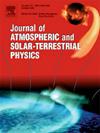Study of rotational temperatures with a multi-wavelength photometer from the Indian equatorial station Tirunelveli
IF 1.9
4区 地球科学
Q3 GEOCHEMISTRY & GEOPHYSICS
Journal of Atmospheric and Solar-Terrestrial Physics
Pub Date : 2025-05-16
DOI:10.1016/j.jastp.2025.106542
引用次数: 0
Abstract
A multi-wavelength photometer (MWP) was operated at the equatorial station Tirunelveli (8.7°N, 77.8°E geographic), India, to study different nightglow emissions. In the present work, the intensities of the P1(2) and P1(4) lines of the OH(6,2) Meinel band were used to derive rotational temperatures in the mesosphere-lower thermosphere (MLT) region during February–April 2015. The methodology adopted to derive rotational temperatures using the MWP data is discussed in detail. A comparison with temperatures measured by the Sounding of the Atmosphere by Broadband Emission Radiometry (SABER) instrument onboard NASA's TIMED satellite was performed to validate the MWP-derived rotational temperatures. An excellent correlation was observed between the MWP-derived and SABER temperatures, with a mean temperature difference of ∼15 K. The plausible reasons for this temperature bias are discussed in this work. In addition, the P1 line intensities of the OH(6,2) band and temperatures obtained with the MWP were compared with the OH broadband intensity acquired by a co-located all-sky airglow imager (ASAI). Furthermore, the local time variation of the MWP-derived temperatures was studied, and the results were compared with the NRLMSISE-00 model simulation. This study demonstrates the effectiveness of the MWP in measuring MLT temperatures and highlights the importance of multi-instrument comparisons for validating the temperatures and airglow intensity.
用印度赤道站Tirunelveli的多波长光度计研究旋转温度
在印度赤道站Tirunelveli(地理位置8.7°N, 77.8°E)使用多波长光度计对不同的夜光辐射进行了研究。本文利用OH(6,2) Meinel波段P1(2)和P1(4)线的强度反演了2015年2 - 4月中低层热层(MLT)区域的旋转温度。详细讨论了采用MWP数据推导旋转温度的方法。与NASA TIMED卫星上的宽带发射辐射测量仪(SABER)测得的大气探测温度进行了比较,以验证mwp导出的旋转温度。在mwp导出的温度和SABER温度之间观察到良好的相关性,平均温差为~ 15 K。本文讨论了造成这种温度偏差的可能原因。此外,将MWP获得的OH(6,2)波段的P1线强度和温度与同位全天气辉成像仪(ASAI)获得的OH宽带强度进行了比较。此外,研究了mwp温度的局地变化,并与NRLMSISE-00模式模拟结果进行了比较。该研究证明了MWP在测量MLT温度方面的有效性,并强调了多仪器比较对验证温度和气辉强度的重要性。
本文章由计算机程序翻译,如有差异,请以英文原文为准。
求助全文
约1分钟内获得全文
求助全文
来源期刊

Journal of Atmospheric and Solar-Terrestrial Physics
地学-地球化学与地球物理
CiteScore
4.10
自引率
5.30%
发文量
95
审稿时长
6 months
期刊介绍:
The Journal of Atmospheric and Solar-Terrestrial Physics (JASTP) is an international journal concerned with the inter-disciplinary science of the Earth''s atmospheric and space environment, especially the highly varied and highly variable physical phenomena that occur in this natural laboratory and the processes that couple them.
The journal covers the physical processes operating in the troposphere, stratosphere, mesosphere, thermosphere, ionosphere, magnetosphere, the Sun, interplanetary medium, and heliosphere. Phenomena occurring in other "spheres", solar influences on climate, and supporting laboratory measurements are also considered. The journal deals especially with the coupling between the different regions.
Solar flares, coronal mass ejections, and other energetic events on the Sun create interesting and important perturbations in the near-Earth space environment. The physics of such "space weather" is central to the Journal of Atmospheric and Solar-Terrestrial Physics and the journal welcomes papers that lead in the direction of a predictive understanding of the coupled system. Regarding the upper atmosphere, the subjects of aeronomy, geomagnetism and geoelectricity, auroral phenomena, radio wave propagation, and plasma instabilities, are examples within the broad field of solar-terrestrial physics which emphasise the energy exchange between the solar wind, the magnetospheric and ionospheric plasmas, and the neutral gas. In the lower atmosphere, topics covered range from mesoscale to global scale dynamics, to atmospheric electricity, lightning and its effects, and to anthropogenic changes.
 求助内容:
求助内容: 应助结果提醒方式:
应助结果提醒方式:


